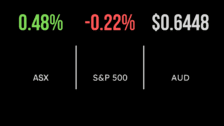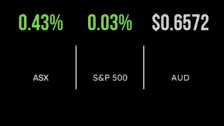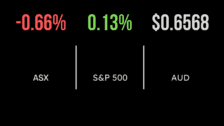ASX closes 0.4% lower, Santos completes merger
ASX losing run snapped, Fortescue CEO leaves, gold miners outperform
The S&P/ASX200 managed to snap a four-week losing run to post a 1.5 per cent gain over the week.
This was despite falling 0.4 per cent on Friday ahead of an all-important inflation print in the US
Shares in Fortescue (ASX: FMG) fell 0.8 per cent after CEO Elizabeth Gaines announced she would be stepping down to join the clean energy-focused Fortescue Future Industries group.
The discretionary and communication sectors were the standout, with Redbubble (ASX: RBL) topping the table again delivering a 10.3 per cent gain as consumer confidence post lockdowns continue to improve.
Iluka Resources (ASX: ILU) was next, adding 7.3 per cent amid a broader rally in the electric vehicle focused commodity sector, with energy once again detracting.
The BNPL sector remains in a correction with Afterpay (ASX: APT) falling another 4.4 per cent.
Over the week it was all about defensive earnings, with the staples and utilities sector both finishing close to 3 per cent higher following Metcash’s (ASX: MTS) earnings and dividend upgrade.
The company topped returns for the week, finishing 13.9 per cent higher, with the gold mining sector seeing support amid spiking global inflation, Santa Barbara (ASX: SBM) up 9.8 per cent.
Magellan’s (ASX: MFG) flow of negative news continued, falling 10 per cent over the five days, with the company now offering a dividend exceeding 8 per cent and growing assets under management.
Inflation highest in 40 years, markets rally, yields remain low, Oracle growth continues
All three US benchmarks posted a week of strong gains, with the Dow Jones finishing 0.6 per cent higher on Friday.
The S&P500 outperformed, gaining 1 per cent and the Nasdaq 0.7 per cent after shares in Oracle (NYSE: ORCL) finished over 15 per cent higher.
The cloud computing and infrastructure application provider reported a US$1.25 billion loss but surging revenue growth which saw sales increase 22 per cent in their core business.
All eyes were on the November inflation print with some experts predicting a rate in excess of 7 per cent.
The end result was a 6.8 per cent increase in prices over the last 12 months, the fastest rate in close to 40 years.
As this was below expectations, the market actually rallied post the announcement.
A closer look shows the main source of inflation remains the increasing cost of energy, 30 per cent contribution, with motor vehicles around 20 per cent.
Over the week the consumer and technology business continued to dominate, with the Dow Jones gaining 4 per cent, the S&P500 3.8 and the Nasdaq weakest up 3.6 per cent despite signs of the rollout of new COVID-19 restrictions around the world.
Inflation, bond rates, Magellan and crypto
It was all about inflation this week as the US economy reported the fastest rate of inflation since the 1980s when interest rates were at significantly higher levels.
The inflation and interest rate decision remains the key talking point, however, the fact that some 50 per cent of the 12-year increase in prices is coming from energy and motor vehicles continues to offer respite given the sector-specific issues facing these costs.
This is a key reason that the 10 and 30-year government bond yields remain at just 1.5 and 1.9 per cent respectively.
The Reserve Bank of Australia appears to be shifting towards the metaverse or at least seeking to embrace digital technology, with Governor Lowe this week announcing that the bank could seek to issue its own digital currency that can be held in wallets, rather than on bank cards, like other tokens.
Magellan remains the talk of the town as the selloff continues following the departure of its CEO and confirmation that Hamish Douglass was indeed separated.
Momentum has clearly taken control, along with growing short positions, with every piece of news met with further falls in the share price.
This is despite the company actually reporting an increase in assets under management this week, improving returns and now yielding some 8 per cent in dividends.










